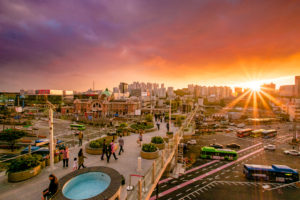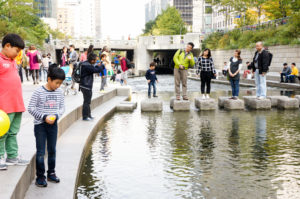American writer Rebecca Solnit described the city as a language and walking as the act of speaking that language. Walking articulates both physical and mental freedom, but today in many societies, people have forgotten the art of walking, and are forced to walk out of necessity or opt instead for motorized transport.
The result has shown harmful effects both on our health and environment. Data from the World Health Organization shows that 9 out of 10 people breath polluted air that exceeds WHO guidelines, leading to 4.2 million premature deaths every year. Additionally, two million people die annually from physical inactivity.
Jim Walker, founder of the Walk21 Foundation, which works with cities to make them more walkable, said that cities need to have a vision that includes a commitment to retain the people walking already, protect them from getting hurt and enable others to walk by improving accessibility and comfort.
“The only real prerequisite for any walkable city is to value walking for the years between the joy of your first steps and the ache of no longer being able as age creeps in,” said Walker.
“Keep people on their feet, don’t let them get hurt and give them a nice time and you will have not just a walkable city, but a city that walks.”

Sunset at skypark, Seoul’s elevated arboretum.
Every year, a city hosts the Walk21 conference, which aims to progress the international agenda on walking. This year the conference is being held in Seoul, The Republic of Korea, and will look at the impact of walking on national and city priorities, and the Walkable City of the future.
Seoul first gained global attention for its eco-city approach in 2005, when it decided to remove a highway and restore the Cheonggyechon stream, which immediately transformed a ribbon of grey pollution into a 50m accessible blue corridor. The decision led to a 15% increase in bus ridership between 2003 and 2008. Similarly, in 2017, the city transformed an abandoned concrete and steel viaduct above Seoul’s main railway station into an elevated arboretum. By 2030 it hopes that car trips and commuter travel time will be cut by a third, green space increased by 30%, and sustainable modes of transport as the first choice for 80% of trips.
“These signature initiatives by Seoul have given us permission to imagine more and more bold ideas,” said Walker.

The restoration of Cheonggyechon stream transformed a ribbon of grey pollution into a 50m accessible blue corridor.
Some of the attributes of a walkable city include transport decisions that give priority to pedestrians; town planning that is people-centred; housing that is connected to public transport; and a minimal risk to walkers from road traffic.
In order for these to be implemented, Walker said, communities need to be part of the solution and political leadership— from transport departments to ministries of economy— must recognise the benefits from walking to human well being, social inclusion, equity, air quality and economic vitality.
“Investing in non-motorized transport – like walking and cycling – helps improve air quality and road safety,” says Rob de Jong, Head of Sustainable Mobility at UNEP. Prioritizing active mobility contributes not only to human health but also can create less polluted, more liveable and resilient cities in the future.
“National and city governments have a significant role to play in developing scalable solutions to air pollution,” says Soraya Smaoun, Air Quality Coordinator at UNEP. Particularly, “in raising awareness about its health impacts and in promoting behavioural changes with clean air co-benefits.”
Governments must also highlight the importance of walking to citizens, said Thiago Herick de Sa, technical officer for the Urban Health and Transport unit at WHO. “In many western societies people have lost the ability to walk in much the same way they have lost the ability to cook,” he added.
On the other hand, in developing countries there is a different challenge. For instance in Accra, thousands of people walk every day but 95 per cent of roads do not have adequate walking infrastructure, meaning they walk in unsafe conditions.
“While we should maintain walking levels in many places, they need to be in a safe and clean environment,” said Herick de Sa.
WHO’s Health economic assessment tool (HEAT) for walking and for cycling is an online tool for governments to estimate the value of reduced mortality that results from regular walking or cycling.
Hero photo © Zoran Zeremski via Adobe Stock; Sunset at skypark © SiHo via Adobe Stock; and Cheonggyechon stream © InHabitat via Flickr